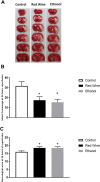Effect of Low-Dose Alcohol Consumption on Inflammation Following Transient Focal Cerebral Ischemia in Rats
- PMID: 28970514
- PMCID: PMC5624984
- DOI: 10.1038/s41598-017-12720-w
Effect of Low-Dose Alcohol Consumption on Inflammation Following Transient Focal Cerebral Ischemia in Rats
Erratum in
-
Author Correction: Effect of Low-Dose Alcohol Consumption on Inflammation Following Transient Focal Cerebral Ischemia in Rats.Sci Rep. 2019 Apr 17;9(1):6404. doi: 10.1038/s41598-019-42589-w. Sci Rep. 2019. PMID: 30996243 Free PMC article.
Abstract
Increasing evidence suggest that low-dose alcohol consumption (LAC) reduces the incidence and improves the functional outcome of ischemic stroke. We determined the influence of LAC on post-ischemic inflammation. Male Sprague-Dawley rats were divided into 3 groups, an ethanol (13.5% alcohol) group, a red wine (Castle Rock Pinot Noir, 13.5% alcohol) group, and a control group. The amount of alcohol given to red wine and ethanol groups was 1.4 g/kg/day. After 8 weeks, the animals were subjected to a 2-hour middle cerebral artery occlusion (MCAO) and sacrificed at 24 hours of reperfusion. Cerebral ischemia/reperfusion (I/R) injury, expression of adhesion molecules and pro- and anti-inflammatory cytokines/chemokines, microglial activation and neutrophil infiltration were evaluated. The total infarct volume and neurological deficits were significantly reduced in red wine- and ethanol-fed rats compared to control rats. Both red wine and ethanol suppressed post-ischemic expression of adhesion molecules and microglial activation. In addition, both red wine and ethanol upregulated expression of tissue inhibitor of metalloproteinases 1 (TIMP-1), downregulated expression of proinflammatory cytokines/chemokines, and significantly alleviated post-ischemic expression of inflammatory mediators. Furthermore, red wine significantly reduced post-ischemic neutrophil infiltration. Our findings suggest that LAC may protect the brain against its I/R injury by suppressing post-ischemic inflammation.
Conflict of interest statement
The authors declare that they have no competing interests.
Figures





Similar articles
-
Chronic Low-Dose Alcohol Consumption Attenuates Post-Ischemic Inflammation via PPARγ in Mice.Int J Mol Sci. 2021 May 12;22(10):5121. doi: 10.3390/ijms22105121. Int J Mol Sci. 2021. PMID: 34066125 Free PMC article.
-
Influence of low-dose alcohol consumption on post-ischemic inflammation: Role of cystathionine γ-lyase.Alcohol. 2019 May;76:81-89. doi: 10.1016/j.alcohol.2018.08.005. Epub 2018 Aug 21. Alcohol. 2019. PMID: 30597416 Free PMC article.
-
Anti-inflammatory effects of Gualou Guizhi decoction in transient focal cerebral ischemic brains. [Corrected].Mol Med Rep. 2015 Jul;12(1):1321-7. doi: 10.3892/mmr.2015.3511. Epub 2015 Mar 19. Mol Med Rep. 2015. PMID: 25815521
-
Modulation of neuro-inflammation and vascular response by oxidative stress following cerebral ischemia-reperfusion injury.Curr Med Chem. 2008;15(1):1-14. doi: 10.2174/092986708783330665. Curr Med Chem. 2008. PMID: 18220759 Review.
-
Inflammatory mechanisms in ischemic stroke: role of inflammatory cells.J Leukoc Biol. 2010 May;87(5):779-89. doi: 10.1189/jlb.1109766. Epub 2010 Feb 3. J Leukoc Biol. 2010. PMID: 20130219 Free PMC article. Review.
Cited by
-
Endothelial Homeostasis Under the Influence of Alcohol-Relevance to Atherosclerotic Cardiovascular Disease.Nutrients. 2025 Feb 26;17(5):802. doi: 10.3390/nu17050802. Nutrients. 2025. PMID: 40077672 Free PMC article. Review.
-
Chronic Low-Dose Alcohol Consumption Attenuates Post-Ischemic Inflammation via PPARγ in Mice.Int J Mol Sci. 2021 May 12;22(10):5121. doi: 10.3390/ijms22105121. Int J Mol Sci. 2021. PMID: 34066125 Free PMC article.
-
Didymin Alleviates Cerebral Ischemia-Reperfusion Injury by Activating the PPAR Signaling Pathway.Yonsei Med J. 2022 Oct;63(10):956-965. doi: 10.3349/ymj.2022.0040. Yonsei Med J. 2022. PMID: 36168249 Free PMC article.
-
Dose-Dependent Influences of Ethanol on Ischemic Stroke: Role of Inflammation.Front Cell Neurosci. 2019 Feb 12;13:6. doi: 10.3389/fncel.2019.00006. eCollection 2019. Front Cell Neurosci. 2019. PMID: 30853895 Free PMC article.
-
Neuroprotective effect of ethanol and Modafinil on focal cerebral ischemia in rats.Metab Brain Dis. 2019 Jun;34(3):805-819. doi: 10.1007/s11011-018-0378-0. Epub 2019 Jan 15. Metab Brain Dis. 2019. PMID: 30644018
References
Publication types
MeSH terms
Substances
Grants and funding
LinkOut - more resources
Full Text Sources
Other Literature Sources
Medical
Research Materials
Miscellaneous

